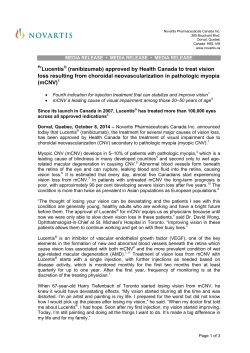
Elisa for Lucentis - WHM Biologics, Inc.
Package Insert M W H WHM Biologics Ranibizumab Kit (Lucentis) Enzyme immunoassay (EIA) for the simultaneous quantitative or qualitative detection of Lucentis. M Inc. WHM WBiologics Redwood City CA, 94063 WHMbiologics@gmail.com H at 4-6 weeks intervals. * The long-term local and systemic effect of Ranibizumab is unknown because of its long half-life and its suppression of VEGF (vascular endothelium growth factor). Therefore the need for a sensitive and accurate assay is imperative to understand and prevent potential damaging side effects. 3 Principle The Ranibizumab (Lucentis) Assay is a solid-based enzyme immunoassay with a sequential addition and incubation steps in its protocol. The test is a colorimetric microtiter plate enzyme immunoassay for the direct determination of Ranibizumab in serum or plasma. The assay protocol includes: 1. Incubation/shaking of the sample with the microtiter well coated plate 2. Discarding contents of the wells, followed with addition of enzyme conjugate, shaken and followed by a wash sequence 3. Formation of blue color with TMB substrate 4. Addition of 3N HCl to stop the enzyme/substrate reaction giving a yellow color. The color intensity is measured as optical density (absorbance) on a microtiter plate reader at 450nm. * The absorbance value is directly proportional to the concentration of Ranibizumab in the sample. W 4 Materials Provided 1. Lucentis Assay Kit Components (96 tests) 2. Lucentis Microwell Strips (1 plate of 96 coated wells) 3. Lucentis Enzyme Conjugate Reagent (8ml) 4. Rinse Solution Concentrate (50ml) 5. Substrate/Chromogen Reagent (11ml) 1 Intended Use 6. Stop Solution/ 3N HCL (10ml) The Ranibizumab (Lucentis) EIA test kit is an in-vitro 7. Stock standard/Negative standard (10 ml) enzyme immunoassay for the quantitative determination 8. Standard Calibrator Concentrated (100ng/ml) 1ml of Lucentis in serum or plasma. 2 Introduction * Ranibizumab (trade name Lucentis, Genentech/Roche) is an angiogenesis inhibitor, a drug that slows the growth of new blood vessels. It is used for the treatment of diseases of the eye in macular degeneration, diabetic retinopathy and retinopathy of prematurity. * The intraocular dose is 1.25 mg to 2.5 mg in 100 ul (0.1ml) injections. The lower dose is usually preferred in premature newborns to prevent retinal blindness. Lucentis microwell strips and enzyme conjugate are provided as matched set. Do not interchange components of kits with different lot numbers. * The higher dose(s) is for adults with macular degeneration Other Materials and Instrumentation Required * * * * * * * * * * Squirt bottle for dispensing 500ml of rinse solution Graduated cylinder for measuring 450ml Distilled water Single channel pipette and tips for dispensing 60ul Multi-channel pipettes, tips and reservoirs or repeating pipettes and tips for dispensing 50ul, 75ul, and 100ul Absorbing toweling Clock or timer Microtiter plate reader that is capable of reading optical density (OD) of 450nm and printing absorbance values Tubes for diluting samples Microtiter Plate Shaker Preparation of Assay Components * The Rinse Solution Concentrate must be diluted before use; pour the vial contents into a large squirt bottle and add 450 ml of di-water to make the rinse solution. * The other Lucentis Assay reagents are provided ready to use. * Calibrator Dilution: 100ng/ml 50/ml, 25ng/ml, 12.5ng/ ml, 6.25ng/ml, and 3.125ng/ml Storage of Assay Components * Store the reagents refrigerated at 2-8º C (36-46º F) Close the reagents vials when not in use. * After dilution, store the rinse solution at room temperature. * Store the microtiter strips/wells at room temperature or refrigerated in the airtight bag with provided desiccant. * Do not freeze the reagents or the microwell strips. Avoid prolonged exposure to temperatures above 32º C. * When stored as directed, the reagents and microwell strips are stable until the expiration date on the kit. Improper storage of reagents and microwell strips can affect assay performance. H Note: Calibrator 100ng/ml should be diluted using the negative standard calibrator provided to the following concentrations: a) 100ng/ml b) 50ng/ml c) 25ng/ml d) 12.5ng/ml e) 6.25ng/ml f) 3.125ng/ml M 5 Preparation and Storage of Assay Components 6 Precautions * Do not use the kit after the expiration date. * Stop Solution contains 3N hydrochloric acid, which causes burns and is harmful, if inhaled, swallowed, or absorbed. In 9 Assay Procedure 1. Bring all specimens and assay components to room A representative standard curve is exhibited in the following: temperature (20-25º C , 68-77º F) and swirl each vial. Ensure that the rinse solution has been prepared by diluting the Rinse Solution Concentrate. * Handle all materials and patient samples as if potentially 2. Place Lucentis Microwells securely in the holder for each infectious. sample, control and standard to be run. * Always wear gloves when handling reagents and samples. Note: If the plate is not used completely, place the non-used strips/wells back in the bag with the desiccant and seal 7 Specimen Collection, Preparation, Note: For reliable and consistent results, perform the following and Storage steps at a steady pace without interruptions. Either serum or plasma can be used with the Lucentis 3. Dispense 60ul of sample (plasma), control, standards and Assay Kit. Samples may exceed the calibration range of calibrators into each well. the assay kit. Pre-dilution of the samples with wash buffer 4. Place the plate on a shaker for 45 minutes. may be required. Serum or plasma samples may be stored 5. Flick out the liquid contents of the plate into an appropriate for a few days at 2-8º C. Samples can be frozen at -20º C waste container. Add 75ul of Lucentis Enzyme conjugate. • for extended time periods. Multiple freeze/thaw cycles of• 6. Place plate on a shaker for 15 minutes. Note: the standard curve is for the purpose of illustration samples should be avoided. 7. Flick out the liquid contents of the plate into an appropriate only and should not be used to calculate unknowns. 8 Calibration and Quality Control waste container. Wash all the wells approximately 7-10 11 Limitations Calibrate and run controls with each batch of samples. times under cold running tap water. Flick out the tap water * TBD Run calibrators and controls in duplicate until satisfactory after each wash. precision is established. Analyzed control values and trends 12 Cross-reactivity/ Interference 8. Fill each well to rim with rinse solution. Flick out the rinse using appropriate statistical methods. * No Crossreactivity with: Rab-IgG, Human-IgG, solution, then pound the plate dry on an absorbent towel. Mouse-IgG, Rat-IgG and Pig-IgG. 9. Add 100ul of Substrate/Chromogen Reagent to each well. Tap the plate gently to mix. Incubate 30 minutes at room temperature. 10. Add 50ul of Stop Solution. Tap the plate gently to mix. 11. Immediately read the plate on a microtiter plate reader at 10 Calculation of Results 1. Calculate the average Absorbance at 450nm value for each sample and standard. • 2. Construct a standard curve by plotting the average• Due to the biological properties of Lucentis and Avastin this assy with detect both compounds. DO NOT quantitate Lucentis samples against Avastin Kit and Vice Versa absorbance for each calibrator against its concentration (ng/ml) on graph paper. Plot absorbance on the vertical (y) axis and concentration on the horizontal (x) axis. 3. Using the average absorbance value for each sample, determine the corresponding Lucentis concentration from the standard curve. Note: Multiply the sample dilution factor with the corresponding sample concentration from the graph to obtain the actual sample concentration M W H
© Copyright 2025









